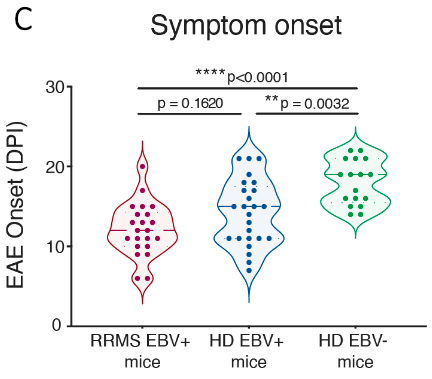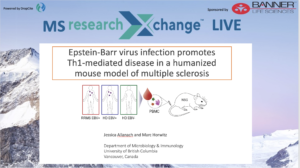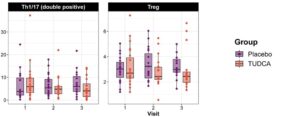
After presenting their research at our most recent MS researchXchange Live Event, Jessica Allanach and Dr. Marc Horwitz sat down with us to talk about their work in greater detail. Part 1 focuses on the finer points of their mouse model of EBV and MS. In Part 2, they discuss EBV and MS in humans. In Part 3, they describe their scientific journey to where they are today.
Andrew Haughin-Scasny: Your studies are not the first ones to take a look at the effect of EBV in humanized mice. What are the advantages to the approach that you use compared to previous ones?
Jessica: There are different ways to study EBV infection in humanized mice, depending on how you humanize your mice. The advantage of using a PBMC system is that you’re taking EBV that has endogenously infected people, so the system you give has gone through a proper response to EBV and exposure. You’re transferring in an entire immune set that’s been properly exposed naturally.
Marc: I would add that because we were most interested in the latent infection, the PBMC model where it’s already latent in the individual is the better model to look at, versus one where you would infect acutely and wait for latency to set in in a non-human situation.
A: As you mentioned early on in your presentation, the timing of EBV infection and whether it leads to infectious mononucleosis seems to play an important role. Would it be feasible to perform experiments similar to those in your study using EBV-positive donors who did not develop infectious mononucleosis?
J: I believe all of our donors didn’t have a recollection of mono. The main problem is that mono is generally waved off in clinic and people don’t properly report or document those events or don’t bother investigating it since it’s such a mild issue on its own. So, it would be hard to know who did or didn’t have mono.
A: One proposed model for EBV and MS involves “molecular mimicry,” where antibodies against EBV proteins cross-react with host proteins to trigger an autoimmune response. In light of results showing exacerbated EAE with minimal B-cell engraftment, how important do you feel those autoantibodies are in mediating the effects of EBV infection?
M: I think it takes a lot more than mimicry to drive an autoimmune disease. And mimicry isn’t the answer for initiation of an autoimmune disease. You need something a bit stronger.
J: I think also the data that we showed where we use gammaherpesvirus 68 (GH68) in B6 mice and saw the same effect would suggest it’s not an epitope- or antigen-specific effect because there’s no EBNA1 in GH68. So, these are more broad effects mediated by latent infection that isn’t necessarily specific to one piece of a protein that looks similar to myelin.
A: Your model puts emphasis on the role of T-cells in EAE. During the Q&A period, Mike Racke mentioned how MOG35-55 can induce EAE in mice that are deficient in B-cells. How do you square this with the success of numerous DMTs that target B-cells?
J: MOG35-55 is just one chunk of MOG protein that’s expressed on the surface of the myelin sheath. And it’s specifically the epitope in B6 and NOD mice that’s presented to CD4+ T-cells, so it promotes that angle. But if you immunize B6 mice with rhMOG protein, they have a B-cell-dependent disease phenotype, so there have been studies before where they’ve done peptide and protein induction in B-cell deficient or WT B6 mice. It’s the protein induction that actually mimics the clinic the best, because it’s unlikely that MS is triggered in a person by one little peptide. It’s probably an inflammatory response to a lot of proteins in one area. So I would argue that the MOG35-55 model is not as representative of human MS as using full-length protein, because you are skipping that B-cell component. If you B-cell deplete mice undergoing EAE with rhMOG induction, they do show clinical improvement the way that humans do.
A: What mechanisms do you believe are behind the deficiency in Tregs in your model? And are there any existing drugs that would target these mechanisms?
M: I think that we don’t know the answer. I think that the latent state of the virus prefers that there are fewer Tregs for whatever reason. It doesn’t actually make any sense, because you would think that it might want more Tregs for when it amplifies. But it seems to reduce the number of Tregs. There must be an evolutionary reason why it’s chosen to do this, and it may be some interaction with the Tregs have with the B-cells that we don’t understand. But it may also be coming through the dendritic cells to maximize its Th1 ability, so that when EBV reactivates or it thinks that EBV is reactivating, it can have a stronger, quicker Th1 response.
J: I did see another theory that there’s a dynamic interplay between the T-cell response and the degree of latency that’s experienced to avoid pathology to the host. EBV wants a less regulated environment that’s more inflammatory so that it’s less likely to reactivate and then cause disease. So, for its own purposes, it might help it hide better if there’s more effector T-cells relative to regulation. It might just be a consequence of this virus wanting to stay hidden and using the external force of the immune system to keep it locked down in the B-cell. That happens to also make people more susceptible to autoimmune disease separately.
A: Given that mice do not get EBV infections or MS proper, what are the limitations of mouse models and making inferences about EBV and MS?
J: I guess the first thing is the protein/peptide difference. You have to understand which components of the immune system you’re actually activating, whichever model you’re using. So that’s one caveat.
M: GH68 actually pretty much mimics as best we can an EBV infection. The mice get sick, it looks something like mononucleosis, and then the virus is latent afterwards. The virus itself isn’t exactly EBV. You would say it doesn’t look like EBV if you look at the genetic sequence, it is in the same family of gammaherpesviruses. But so is Kaposi’s Sarcoma Virus, which is a human virus that seems to be some sort of version in between. It seems like GH68 infection is actually something that actually happens in the wild. Mice and rats don’t live a long lifespan. So, autoimmunity may not be an issue long-term for them.
But it’s still a natural virus found in the wild in a rodent, and in a laboratory mouse, it has caused a very similar disease. So, from that aspect, I think that’s a good representation. There are also other natural viruses that are in the gammaherpesvirus family targeting nonhuman primates that have been linked to MS-like disease. As Steve mentioned one in the discussion on Thursday, there’s one in Japanese Macaques that they see down at the Portland Primate Center that leads to this MS-like disease, where some of them are not able to use one of their legs very well or their tail has some paralysis. So I think gammaherpesviruses are linked to autoimmunity in different animals.
And then the other part of your question – I don’t believe EAE is an example of how we get MS. All it is, is an example of basically taking antigen from the target, which we understand to be the myelin sheath, and causing inflammation. We can do the same experiments with collagen-induced arthritis where you take collagen instead of myelin and then you get inflammation towards the joint. In the background of a gammaherpesvirus infection, you get increased arthritis, much more like the clinical model.






